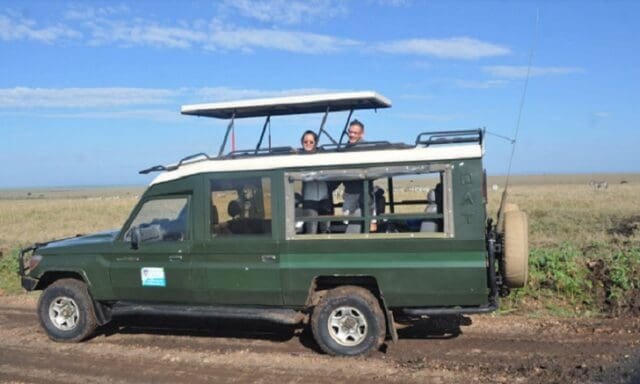
Going on Safari in Kenya was once seen as a white colonial preserve, when khakhi-clad big game hunters would prowl the savannah followed by teams of porters and servants. But things have changed as almost two-thirds of visitors are now Kenyans.
Nairobi – Proudly pointing to her newly bought T-shirt, Sarah Mukei reads out animals printed on the front, a treasured souvenir of a family’s trip from her home in Kenya’s capital to Nairobi’s national park.
“Elephant, lion, buffalo and rhino, leopard,” the 10-year old reads, adding she had just seen three of the “big five” animals listed.
Going on safari – meaning simply “travel” in east Africa’s Swahili language – was once seen as a white colonial preserve, when khaki-clad big game hunters would prowl the savannah followed by teams of porters and servants.
Things however have changed. Kenya’s tourism industry relies on higher paying foreigners to bankroll the running of the parks, but thanks to a burgeoning national middle class almost two-thirds of visitors are now Kenyans.
“It’s been a wonderful visit, something all the family has enjoyed,” said Sarah’s father George, an accountant at a small firm in the bustling city centre.
The numbers are growing: Kenyan visitors to national parks rose by 55% over the past five years, according to official figures from Kenya Wildlife Service (KWS).
“The numbers for locals are rising, especially the new emerging middle class in Kenya that show an interest in Kenyan national parks,” said Julius Kipng’etich, KWS director.
“Five years ago, 57% of the people going to national parks were Kenyans – that figure has now moved to 64%.
Natural heritage
On a typical weekend, families and school groups crowd at the entrance of the park, enjoying the dramatic scenery and wild animals that form the remarkable natural heritage of this east African nation.
“It’s good to show the children the animals of their country,” said Mary Ogari, a government civil servant and mother of two. “We live in an apartment block here in Nairobi, so the park is a good place to come out to relax.”
Inside the park lies a rolling expanse of grassland where gazelles, giraffes, lions and other animals roam, protected by a high wire fence on the edge of the rapidly growing city.
Abroad, the persistent image of Africa held by foreigners is often one more of poverty, hunger, corruption or war.
Kenya is not without its problems: a struggling currency, impoverished northern regions hit by harsh drought last year and an army fighting Islamist insurgents in neighbouring Somalia.
But there are signs of more hopeful change. The African Development Bank (AfDB) calculates that the number of middle class Africans has tripled over the past 30 years, now making up more than a third of the continent’s population.
“The West has had a stereotypical view of Africa for a long time,” said Aly Khan Satchu, a Kenyan market analyst.
“But there is an expansion of the middle class – evidenced in the burgeoning mall culture, for example,” he added, citing consumer spending and Nairobi’s booming housing demand as indicators of that change.
The AfDB report, while admitting inherent difficulties in definition, estimates that about 17% of Kenyans could be seen as middle class.
Strong economic growth
Its financial benchmark for the middle class is low – an annual income exceeding $3 900 – but the report notes that other indicators such as education, professions and lifestyle also mark out shifting divisions within society.
“Strong economic growth in the past two decades has helped reduce poverty significantly and lift previously poor households into the middle class,” the AfDB report notes, referring to the whole continent.
While many live in grim poverty in Kenya in crowded shanty districts – a stark contrast to the construction boom of apartment blocks and commercial centres elsewhere in the city – others are succeeding to improve their lives.
“We come here early in the morning because it wastes the day to be stuck in traffic,” said Andrew Kinyua, another visitor at the national park, noting the increasing headache of Nairobi’s sometimes hours-long road jams.
The number of private cars in Kenya more than doubled between 2002-2007, according to AfDB figures, which it points to as another indicator of a changing society.
Kenya’s wildlife authorities are keen to tap into that change, by encouraging people to take their leisure time at the parks, weaning them off the once near total dependency on foreign visitors.
“We have done a lot of marketing to encourage local Kenyans to visit national parks,” Kipng’etich said. “We are excited because then it cushions the industry if the international market suddenly drops.”
The park entrance for Kenyans – $1.50 for an adult, 0.75c for a child – is many times lower than for foreign visitors, but is still a significant outlay for many families here.
“It is not cheap, but when I have some spare money, after all the bills have been paid, it is good to bring the children along,” added Kinyua, a building materials wholesaler. “They enjoy it, and I enjoy it.”
Source-http://www.news24.com/Africa/News/Kenyans-holiday-at-home-20120116
Kenyans holiday at home: Going on Safari no longer for whites







